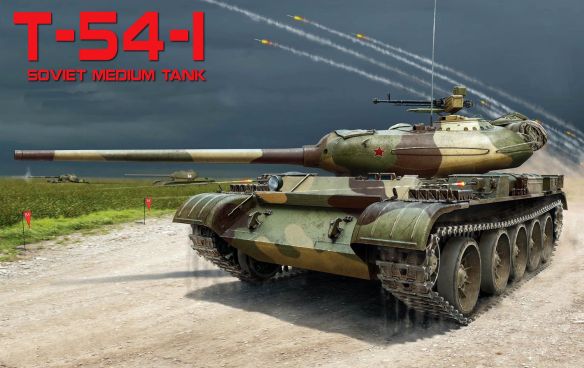The key lesson that the red Army learned from the Second world war was that you needed a lot of everything, especially tanks, to wage modern armoured and mechanized warfare. It was clear from the T-34 and T-44 that they required a tank that was easy to mass-produce in vast numbers, was very reliable and armed with at least a 100mm gun, while the IS heavy tank had been armed with a massive 122mm gun, it meant that it was 20 tons heavier than the T-34/85. experience showed that there was no long-term future in heavy tanks. Thus was born the T-54 MBT.
In 1946 prototypes of a new design, the T-54, were completed and this type entered production several years later. The T-54 and its variants were built in larger numbers than any other Russian tank to appear after World War II, and by the time production of the improved T-55 was completed in 1980-1 it is estimated that well over 50,000 vehicles had been built. The series was also built in Czechoslovakia and Poland for both the home and export markets, while the Chinese produced an almost identical version designated Type 59. Further development of the T-54 and T-55 resulted in the T-62.
The T-54 has an all-welded hull divided into three compartments (driver’s at the front, fighting in the centre, and engine and transmission at rear). The driver is seated at the front of the hull on the left and steers the tank with conventional sticks. An unusual feature of the T-54 is that it has a 7.62-mm (0.3- in) machine-gun fixed in the centre of the glacis plate to fire forwards, this being fired when the driver presses a button on his right steering lever. The commander and gunner are seated on the left of the turret, with the loader on the right. The turret is a casting with the top welded into position. One of the major weaknesses of the T-54 series has been its engine and transmission, which have proved very unreliable in service.
The main armament consists of a 100-mm gun, which was developed from a naval weapon of the same calibre and also used in a modified form in the SU-100 tank destroyer developed in World War II. A well-trained crew can fire about four rounds per minute, and the types of ammunition that can be fired includes AP-T, APC-T, HE, HE-FRAG, HEAT-FS and HVAPDS-T. The last was introduced some time after the T-54 entered pro¬ duction and will penetrate well over 200 mm (7.9 in) of armour at a range of 1000 m (1,095 yards). A total of 34 rounds of 100-mm ammunition is carried, a poor quantity when compared with contemporary Western tanks. One of the major drawbacks of the T- 54 family is that the main armament can only be depressed to -4°, which makes firing from a hill or reverse slope almost impossible. A 7.62-mm (0.3 in) SGMT is mounted co-axially with the 100-mm gun, and a similar weapon is mounted in the bow. A 12.7- mm (0.5-in) DShKM anti-aircraft machine-gun is mounted on the loader’s hatch. The tank does not have smoke dischargers as it can lay its own smoke screen by injecting diesel fuel into the exhaust pipe on the left side of the hull just above the track.
The T-54 was effectively a Ukrainian tank. Under the designation of Obiekt 137 (or B-40) it was designed by the Morozov Bureau at the Malyshev Plant in Kharkov, Ukraine. The city had been producing T-34s at the start of the Second world war but was captured during the German invasion. It subsequently became the scene of a series of battles fought between the Wehrmacht and the red Army before being finally liberated. However, the Kartsev Bureau at Nizhnyi Tagil in Russia would take the credit for the T-54/55.
The T-54 made its debut in the late 1940s with the first prototype appearing in 1946 and initial production authorized three years later. Three factories were given the task, at Kharkov, Nizhnyi Tagil and Omsk. It and the subsequent T-55 went through numerous upgrades, rebuilds and reconfigurations and unless you are a specialist technical intelligence expert trying to identify them all is a largely fruitless task (some sources are downright contradictory or are simply incorrect). essentially the T-54 and T-55 were the same tank with detailed improvements. The following lists the key T-54 production models.

T-54-1 (Model 1946)
This bore some resemblance to the T-44, with undercuts to the front and rear of the turret. Similarly, it also had a very wide gun mantlet but was armed with the 100mm d-10T tank gun. These features made the turret vulnerable to enemy fire. It was issued to field units for trials but proved unsatisfactory and in the meantime the focus remained on T-34/85 production.
T-54-2 (Model 1949)
This was the very first low-rate production model with an improved turret that eliminated the frontal undercut, featured an overhang at the rear and was armed with the 100mm d-10T tank gun.
T-54-3 (Model 1951)
Second low-rate production model, featuring a turret undercut at the rear and a narrow, so-called `pig snout’ gun mantlet.